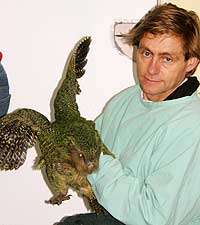Geometric model could mean breakthrough in saving endangered kakapo

(PhysOrg.com) -- A mathematical model used to assess the nutrient balance of the kakapo diet has the potential to help solve one of the main challenges to saving the endangered native parrot.
Nutritional ecologist Associate Professor David Raubenheimer may have found a way to get kakapo to breed more often.
While conservationists working to save the species are thrilled the kakapo population has been boosted from 86 to 91 this year, female kakapo tend to lay eggs only every three or four years.
Because of a phenomenon known as "masting", the world's largest and rarest parrot breeds only when rimu trees fruit heavily, which occurs only every three to five years.
Dr Raubenheimer, who recently joined the College of Sciences' Institute of Natural Resources at the Auckland campus, has been working with the Conservation Department's kakapo recovery team for the past three years on a project to supplement the birds' diet.
Department scientist Ron Moorhouse says Dr Raubenheimer's tool “provides a potential for a breakthrough" in understanding kakapo diet and nutrition. "It could help us understand something we've been puzzled about for a long time.”
The mathematical tool, called the geometric framework for nutrition, is being used to try and determine the best food for kakapo in years when rimu trees do not fruit. The tool compares - through graph representation - the balance of nutrients needed by animals and the balance of nutrients in foods. It has been used to analyse dietary components and their consequences for other birds as well as humans, spiders, insects and fish.
Until now, the conservationists have favoured protein-enriched food supplements for kakapo, on the basis that protein is known to be an important nutrient for breeding in many species. But Mr Moorehouse says 25 years of experimenting with a variety of nutritional supplements has not led to a marked improvement in kakapo breeding.
Dr Raubenheimer's analyses suggest that it is unlikely that protein is the limiting nutrient for kakapo breeding, but rather that calcium is.
"Calcium is needed in high levels during breeding, for the development of egg shells and for bone growth," Dr Raubenheimer says. "It is also significant that kakapo have an unusually large skeleton and hence a high demand for calcium."
Rimu fruit contains high levels of calcium, which might be the reason that kakapo breed only when these are abundant.
Using the tool, scientists will try to work out the correct balance of calcium to introduce to the diet and hope that will lead to more regular breeding and hasten population growth.
Mr Moorhouse says the department hopes to test a new, carefully-refined supplement based on Dr Raubenheimer's analyses as soon as next February if the anticipated rimu fruit masting in this period fails. Otherwise, they will have to wait another season before finding out whether they can trigger breeding with a duplicate of the rimu fruit's unique nutritional blend, or whether kakapo are simply “hard-wired” to breed only when they can feed on ripe rimu fruit.
Kakapo live on two predator-free islands - Codfish Island, off the west coast of Stewart Island, and Anchor Island, in Dusky Sound, Fiordland.
Provided by Massey University





















